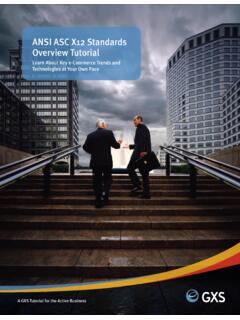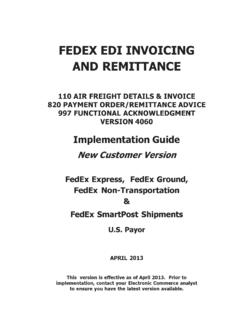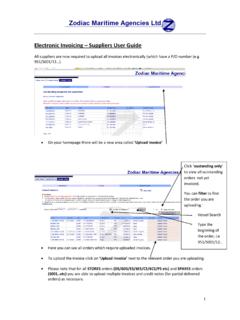Transcription of The Ten Business Benefits of E-Invoicing
1 A GXS INSIGHTS ARTICLET here are numerous Benefits to be gained by shifting away from paper and manual based invoice processing to more digitised approaches. As with any automation project, the cost savings that can achieved from E-Invoicing will vary based upon the starting point. Companies which only send paper invoices via post will generate the most savings. Other companies which using Optical Character Recogni-tion (OCR) scanning techniques to convert paper invoices into electronic format have already achieved significant cost savings even though they have not truly shifted to a digital invoice model.
2 Proper electronic invoicing is considered by most to be the transmission of a structured EDI or XML document from the supplier into the buyer s Account s Payable (AP) system. Depending upon the location of the buyer or supplier, regulations also may require a govern-ment issued identification number, qualified electronic signatures, specific content fields and long-term archival of the are ten key Business Benefits that AP organisations can expect to gain from a shift toward electronic invoices: 1. Digital Invoice Capture Invoices received as a PDF attachment to an e-mail or via post introduce un-necessary costs and complexities into the AP and Accounts Receivable (AR) processes.
3 For invoices received via post, the documents must be sorted, routed, opened and rekeyed into an AP system. For invoices received via e-mail, the documents must be saved, printed, rekeyed and possibly forwarded. Data re-entry is the most problematic of the processes as it is time-consuming and error-prone. E-Invoicing fully automates the invoice capture process with data be-ing routed straight from the supplier into the buyer s AP system. 2. Automated Invoice Validation Most AP organisa-tions perform validations of line items on the invoice before routing the invoice to Line of Business man-agers for approval.
4 For example, buyers often require suppliers to list the buyer s part number, buyer s pur-chase order number and general ledger or cost code on an invoice. Such references enable the AP depart-ment to quickly identify the goods being purchased and the department responsible. In addition, AP clerks will need to ensure that the arithmetic such as the calculation of extended costs is accurate. There may be a need to validate VAT or GST calculations as well. In addition to capturing the data electroni-cally, most E-Invoicing solutions will also perform field-level validations of the content as well.
5 3. Automated Matching One of the more complex validations performed is the matching between an invoice and the related documents in the procure-to-pay lifecycle. The pricing and terms on an invoice should match those negotiated in the master contract with the vendor. Additionally, the line-item quanti-ties, product descriptions and per-unit pricing on the invoice must match those of the purchase order and the actual goods received. These matching processes can be performed manually. However, the costs, accuracy and time required for the validations can be significantly reduced through automation.
6 A key component of an E-Invoicing solution should be matching process between the contracts, PO, invoice and goods receipt notice. 4. Vendor Self-Service Perhaps, the most costly aspects of invoice processing is not the capture or validation of the data, but staffing call centres to sup-port vendor inquiries about payments. After submit-ting an invoice the collections and AR teams within a supplier will typically contact the buyer to confirm receipt and approval of the invoice. Following the approval, the supplier may follow up again to inquire about the actual payment date.
7 Significant time and expense is incurred responding to vendor calls and researching the status of invoices. A key element of any E-Invoicing program should be a portal which offers vendors the ability to check the status of ap-proval processing or planned payment. 5. Enhanced Cash Management Paper or e-mail based invoices take longer to become visible in AP systems. Paper and e-mail based documents also have a higher probability of being lost in the approval process. Without visibility to invoices in the approval process, cash managers lack the comprehensive data neces-The Ten Business Benefits of E-Invoicingsary for forecasting.
8 A large invoice, which is not discovered by the treasury organisation until shortly before payment, could result in a significant cash deficit relative to forecast. As a result, a Business may need to borrow funds at the last minute at a relatively expensive premium. By processing invoices electronically, all upcoming payments become visible to the treasury organisation in the accounting system improving forecast accuracy. 6. Enhanced Account Reconciliation Suppliers are of-ten challenged to reconcile the payments they receive from customers against the original invoices they submitted.
9 A supplier may have submitted 4 in-voices for 5000 during a single month, but received a single payment for 18,000. To reduce banking fees, customers will frequently consolidate payments for multiple invoices into one single funds trans-fer. Additionally, customers may claim deductions against an invoice due to shipment problems such as damaged or missing items. Upon receiving a consoli-dated payment, confused suppliers will frequently call the buyer s AP department to inquire about the details behind funds received.
10 To simplify account reconciliation for suppliers, customers should send electronic remittance advices along with a payment that provide a detailed accounting of the invoices paid as well as debits, credits or adjustments taken. 7. Lower Carbon Footprint Proponents of E-Invoicing also promote the lower carbon footprint of electronic transactions. In theory no paper is consumed. Nor is there any transportation of the paper from supplier to the buyer. Although the digitisation of a single invoice does not lower greenhouse gas emissions sig-nificantly, the cumulative effect of removing millions of paper invoices from the financial supply chain is impactful.






